 My mother asked me to make a couple of ‘lemony sponge cakes’ for my parents’ 40th wedding anniversary party last Saturday (Happy Anniversary, Mum and Dad!). I immediately suggested the insane lemon meringue cake that I like to make for special occasions, but Mum wanted something simpler, so I agreed to make two or three lemon curd sponge cakes. (‘Two or three cakes’ will always mean ‘three probably quite large cakes’ where I’m concerned, something which I suspect my mother had not quite grasped, but there you have it.)
My mother asked me to make a couple of ‘lemony sponge cakes’ for my parents’ 40th wedding anniversary party last Saturday (Happy Anniversary, Mum and Dad!). I immediately suggested the insane lemon meringue cake that I like to make for special occasions, but Mum wanted something simpler, so I agreed to make two or three lemon curd sponge cakes. (‘Two or three cakes’ will always mean ‘three probably quite large cakes’ where I’m concerned, something which I suspect my mother had not quite grasped, but there you have it.)
There was just one flaw in this arrangement – I am terrible at traditional sponge cakes. They are my favourite kind of cake and I just can’t make them. I gave up even attempting them about twelve years ago, in fact, because the results were too depressing. So I thought I’d better make a practice cake, and turned to Margaret Fulton for help. It turns out that I’ve actually improved a bit as a cook in the last twelve years (having an oven with accurate temperatures probably helps) (Actually, taking a recipe seriously when it says ‘pre-heat the oven’ helps a lot too – I only figured that one out about ten years ago, and the results have been astonishing. If you have been putting your cakes into cold ovens and wondering why they weren’t working – that’s why).
Anyway, between my increased baking skill, my improved ability to work out which instructions really do need to be followed, and my more accurate oven, my practice cake worked rather well and disappeared rapidly when I took it in to work on Monday, so this morning I got up bright and early, ready to make a lot of sponge cake.
Except… it’s sort of boring making three cakes that are all exactly the same, especially when they are as finicky as sponges. And my brother’s mother-in-law is gluten intolerant, and while I knew Mum was making a flourless chocolate cake especially for her, I couldn’t help feeling that it would be awful if she didn’t get a passionfruit sponge cake. I did have a recipe for gluten-free sponge cake, but it’s one of those ones that involves beating the eggs for ten minutes or until thick and ribbony, which drives me batty, because it is so boring and takes so long and I never really get to the ribbony stage (because I get bored long before that point) and so my cakes are never as good as they should be…
… Which is how I, a self-confessed sponge incompetent, came to invent my own recipe for gluten-free (and, as it turns out, low-fructose) sponge cake this morning. And, astonishingly, it worked (possibly because I used a Margaret Fulton recipe as a template – and nobody is more reliable than Margaret Fulton). Though it is even more finicky and fragile than the kind you make with wheat, so be warned. This sponge is very light and fluffy in texture, and mine had a lot of holes in the bottom, which caused me concern, but when it was sliced, the actual grain of the cake was properly light and spongey – the holes didn’t go through the cake at all. And with a lemon curd and cream filling and passionfruit icing, it was truly delicious.
Of course, I was so convinced it wouldn’t work that I didn’t take any pictures of it yesterday, so I had to make another one today, just for the purposes of this recipe. The things I do for you people… Today’s cake, naturally, didn’t wind up looking nearly so photogenic, not least because we had guests around and I had to ice and fill it before it was completely cool. It still tasted good, though...
Your Shopping List
1 cup cornflour (make sure it is made from corn, not wheat, and it should be the fine, white, squeaky stuff, not yellow polenta / cornmeal) 1 tsp baking powder a pinch of salt 3 eggs, separated + 1 egg white 3/4 cup caster sugar 60 ml very hot water 1 tsp butter, melted + 1 tsp butter for the icing 1 passionfruit 1 cup icing sugar extra butter and cornflour, for the tin whipped cream with a little sugar, and lemon curd to serveNow what will you do with it?
Preheat your oven to 180°C. Grease 2 x 18 cm cake tins with a bit of butter, then put a bit of cornflour in the pan, and turn the pan and tap it, so that the cornflour sticks to the butter and the whole inside of each pan has a cornflour coating.
Sift together the cornflour, salt and baking powder three times. Don’t skip this bit – I generally don’t bother sifting flour in other recipes, but sponges need it. I understand that this gets more air into the flour – at the very least, it removes lumps, which cornflour is very prone to. Ideally, sift it onto a piece of baking paper, pick the sheet of paper up by its corners and then tip it into the sieve over a second sheet of baking paper, then repeat and sift it back onto the first.
Beat the 4 egg whites until you have fairly stiff peaks – you want them to hold their shape firmly, but you don’t need to have them at the ‘turn the bowl upside down over your head without having a surprise meringue shower’ stage. Beat the sugar in in three batches, until the meringue mixture is nice and thick and a bit glossy.
Put the beaters away now, and don’t so much as look at them for the rest of this recipe!
Now is also a good time to melt your butter and bring some water to the boil. I also strongly recommend making sure the baking paper with the flour is well away from the stove top when you do this. (I didn’t actually set the kitchen on fire yesterday, but I gave it a red hot try, if you take my point)
Get out a spatula, preferably a silicone or rubbery one, and gently fold in the egg yolks.
Sift in the cornflour and fold it together some more. I’m not sure how to describe a folding action well – I tend to go all around the edge of the bowl with the spatula and then turn it over, until things are well mixed. This won’t be especially easy – you are trying to get everything combined without beating the air out of it. After all, you went to a lot of trouble to get the air into it…
Pour the just boiled water and the melted butter down the side of the bowl into the batter, and fold everything some more – it will loosen up alarmingly at this point, but that’s cornflour for you – then quickly get it into the two tins and into the oven.
Two things to watch here: don’t bang the tins around to settle the mixture (which should be liquid enough not to need it, but this is a good rule for any sponge), and don’t be so slow that the whole mixture gets bored and decides not to bother rising.
Once the cakes are in the oven, don’t mess with them. They will need at least 20 minutes, probably more like 25, but definitely do not open the oven door for the first twenty minutes. And, while you don’t need to tiptoe around the house, I also don’t recommend jumping up and down in front of the oven. These cakes are fairly fragile.
The cakes will be done when they are nicely golden and you get a bit of resistance when you press the centre lightly with your finger. The skewer test works reasonably well here, but you risk deflating your cake. Keep the cakes horizontal as you take them out of the oven – they will start coming away from the sides almost immediately, and will slump in any direction you allow given the opportunity; I found that turning each cake in turn very quickly onto my hand and then back onto the cooling rack caused minimum deflation and maximum evenness. Though I did burn my wrists doing this, so maybe an oven mitt would be a better plan.
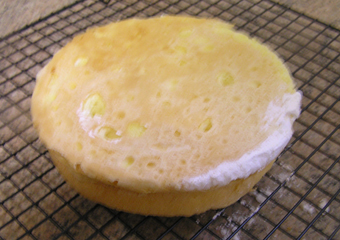
Holes on the bottom of the cake. No idea why and they don’t affect the texture, so don’t let them worry you.
This all sounds horribly intimidating, but it isn’t quite as bad as that. Even my sunken sponge tasted good and had a pretty good texture. And it mostly sank because I had no idea how fragile it was and manhandled it a bit too much – just being aware that you need to be a bit delicate will probably be enough to rescue you – I’m completely clumsy and I still managed it, once I realised what was required.
Another good thing not to do is decide that the cakes aren’t going to rise all that much and there’s no need to shift the upper oven rack a bit higher.
Once the cakes are cool, make the passionfruit icing (I suggest that you make lemon curd the day before, incidentally, so that it is cool. Or you could buy it, but that’s much less fun, and not as tasty). This is really easy, you will be glad to here. Cut the passionfruit in half, and scoop all the pulp and seeds into a bowl. Sift in the icing sugar and mix until you have a thick icing (if it’s really far too thick, add a little lemon juice or water). Beat in the soft butter, and then microwave the whole thing for about a minute on 50%, until it’s liquid enough to pour onto whichever cake is going to be your top cake and then spread out a bit.
Spread the lower cake thickly with lemon curd and then with slightly sweetened, well-whipped cream – you don’t want butter, but you want it to be fairly firm about holding its shape, otherwise it will all start spilling out the sides and the top cake will slide gently off the bottom one. If, like me, you are overly generous with your filling, that might still happen, but at least you have given it a fighting chance.
Eat, with joy.
Variations
You can make this dairy-free by using a dairy-free margarine to replace the tiny amount of butter in cake and icing. Sandwich together with apricot jam and maybe crushed tinned pineapples instead of cream, or with coconut and lemon buttercream (rich, but entirely dairy-free) and ice with passionfruit icing as above.
Eggless sponge is still beyond me, sorry! And I don’t think sponge cake is going to be particularly low-GI any time soon, either.
You can, of course, sandwich this together with anything you like, and you can also top it just with sifted icing sugar. And you can cut the halves into layers and have more layers, too. If you don’t plan to eat this cake the same day you make it – which you really should, if possible – it’s not a bad idea to brush it all over with a lemon and sugar syrup, to keep it moist.
If you want a larger cake, a double quantity of this recipe will fit two 22-23cm sandwich tins – but unless you have an extra wide oven and can fit both cakes on one shelf, I recommend making 23cm cake at a time. I learned the hard way yesterday that even if you wait for most of the cooking time before swapping your cakes around in the oven, they will still try to sink into interesting sin-wave cake shapes, which are excellent for fitting more lemon curd between layers, but not ideal on an aesthetic level.


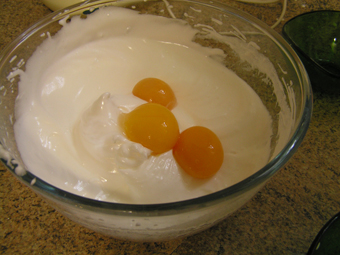


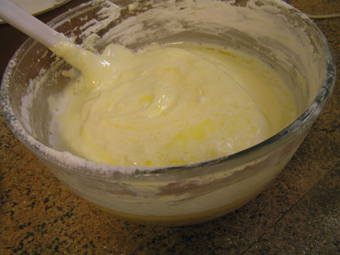


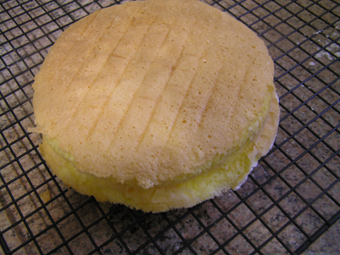
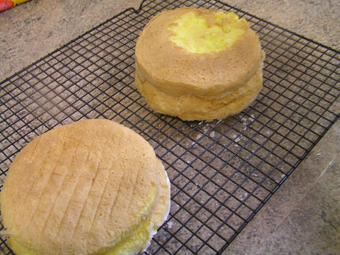

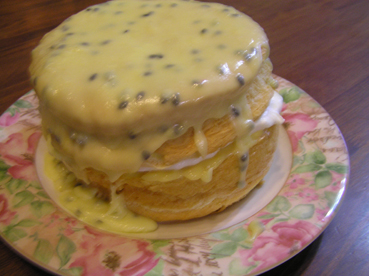
4 comments for “Recipe: Gluten-Free Sponge Cake”